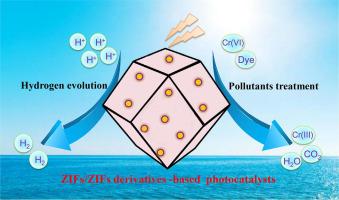Chemical Engineering Journal ( IF 15.1 ) Pub Date : 2020-12-02 , DOI: 10.1016/j.cej.2020.127914 Yang Liu , Hao Cheng , Min Cheng , Zhifeng Liu , Danlian Huang , Gaoxia Zhang , Binbin Shao , Qinghua Liang , Songhao Luo , Ting Wu , Sa Xiao

|
To solve the problem of the global energy shortage and the widespread pollution of the environment, semiconductor photocatalytic technology has been widely studied. Zeolitic imidazolate frameworks, a sub-family of metal-organic frameworks, have emerged as potential candidates for photocatalysis due to their intrinsic porous characteristics, abundant functionalities, rapid electron transfer ability, and exceptional thermal and chemical stabilities. Besides, a thermal treatment of zeolitic imidazolate frameworks can result to functional materials that have the similar structure characteristic, but superior light sensitivity and charge transfer properties. Moreover, the photocatalytic activity of zaeolitic imidazolate frameworks and their derivatives can be largely improved by combining photoactive semiconductors/ molecules which serve as light harvesting centers/electronic mediators. This paper presents a first review of the application of zaeolitic imidazolate frameworks and their derivatives -based materials for visible-light-induced photocatalytic hydrogen evolution and pollutants treatment. The representative studies are carefully summarized and discussed. Special emphasis is given to the synergistic effects between the components in the composite catalyst for enhanced photocatalysis. At the end of this review, the current achievements together with major challenges in the field are discussed and the next possible development directions are proposed.
中文翻译:

沸石咪唑盐骨架(ZIF)及其衍生物基材料在光催化制氢和污染物处理中的应用
为了解决全球能源短缺和环境广泛污染的问题,对半导体光催化技术进行了广泛的研究。沸石咪唑酸盐骨架是金属有机骨架的一个子家族,由于其固有的多孔特性,丰富的功能,快速的电子转移能力以及出色的热稳定性和化学稳定性,已经成为光催化的潜在候选者。此外,对沸石咪唑酸酯骨架进行热处理可以得到功能材料,这些材料具有相似的结构特征,但具有出色的光敏性和电荷转移性能。此外,通过结合用作光收集中心/电子介体的光敏半导体/分子,可以大大提高zaeolitic咪唑酸酯骨架及其衍生物的光催化活性。本文首次介绍了沸石沸石咪唑酸酯骨架及其衍生物基材料在可见光诱导的光催化制氢和污染物处理中的应用。代表性研究经过仔细总结和讨论。特别强调复合催化剂中各组分之间的协同作用,以增强光催化作用。在本文的最后,讨论了当前的成就以及该领域的主要挑战,并提出了下一个可能的发展方向。本文首次介绍了沸石沸石咪唑酸酯骨架及其衍生物基材料在可见光诱导的光催化制氢和污染物处理中的应用。代表性研究经过仔细总结和讨论。特别强调复合催化剂中各组分之间的协同作用,以增强光催化作用。在本文的最后,讨论了当前的成就以及该领域的主要挑战,并提出了下一个可能的发展方向。本文首次介绍了沸石沸石咪唑酸酯骨架及其衍生物基材料在可见光诱导的光催化制氢和污染物处理中的应用。代表性研究经过仔细总结和讨论。特别强调复合催化剂中各组分之间的协同作用,以增强光催化作用。在审查的最后,讨论了当前的成就以及该领域的主要挑战,并提出了下一个可能的发展方向。特别强调复合催化剂中各组分之间的协同作用,以增强光催化作用。在本文的最后,讨论了当前的成就以及该领域的主要挑战,并提出了下一个可能的发展方向。特别强调复合催化剂中各组分之间的协同作用,以增强光催化作用。在本文的最后,讨论了当前的成就以及该领域的主要挑战,并提出了下一个可能的发展方向。



























 京公网安备 11010802027423号
京公网安备 11010802027423号